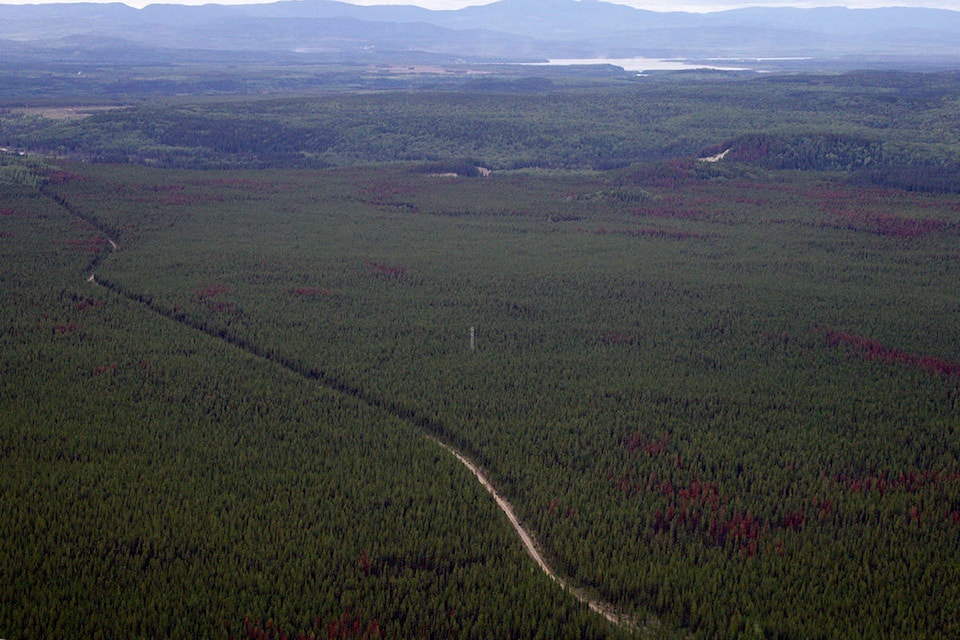In the previous article in this series (see the April 25 edition of the Quesnel Cariboo Observer), Jeanne Robert said the Ministry of Forests (MOF) has some concerns about the current spruce beetle infestation in the Northern Interior. The hectare coverage of the spruce beetle infestation has increased from 150,000 hectares in the Omineca region in 2015 to 340,000 ha in 2017.
The Omineca-Northwest regional entomologist for the Ministry of Forests, Lands, Natural Resource Operations and Rural Development explained the MOF is closely watching this current spruce beetle outbreak because it’s happening within the context of climate change.
“With the warmer, drier summers and milder, warmer winters, we don’t have the historical cold snap in early winter to kill off a large portion of the spruce beetle population that’s beginning to rise.”
Impact detection
Noting it can take 13 to 18 months for the trees to show distress – needles change colour (pale yellow-green to gray-red) – it takes a while before they can be seen from the aerial monitoring. Robert said the ministry uses ground surveys to get a more definitive gauge of the bark beetles infestation.
The MOF ground survey program has expanded beyond Prince George and Mackenzie to Dawson Creek, Chetwynd and the Robson Valley areas this year.
Mitigation plans
Robert said the ministry has two goals while mitigating the outbreak: protecting the Mid-term Timber Supply; and making sure there is a balanced and collaborative approach slowing the spruce beetle spread.
She added the MOF has Timber Supply Working Groups in the major beetle-attacked areas, which brings all of the licensees and government to one table to work out mitigation plans.
“We have groups in Prince George; Mackenzie and the Northeast and the Robson Valley.”
Attacking beetles
The plan is to prioritize areas for “sanitation harvesting,” which is where licensees cut down green beetle-attacked trees and remove the live beetles from the ecosystem, Robert said, adding the intention is to remove the next generation of spruce beetles.
“It depends on the licensees’ operating areas, and what’s accessible now versus what can be accessible in the next two to five years.”
Accessibility is one of the constraints for the mitigation plan. Roads and other infrastructure have to be built to get access to spruce beetle-infested areas.
Forest priorities
While the goal is to mitigate the spruce beetle attack on the Mid-term Timber Supply, it’s also a goal to balance that with the non-timber values and priorities, Robert said.
Non-timber values include caribou, ungulate winter range, fisheries, sensitive watersheds, old-growth management areas and other habitat-sensitive issues.
“[The ecosystem] has to be looked at in a holistic way. We simply can’t chase after just spruce beetle….”
Cariboo spruce
Robert said there are spruce ecosystems in the Quesnel Timber Supply Area and, therefore, there are spruce beetles.
“It’s not so much we have an epicentre moving outward. What we have is an endemic population having conditions that allow them to increase their populations throughout the province.”
Because spruce beetle ecosystems have a rise-and-fall history, she added it wouldn’t surprise her to see a spruce beetle increase in the Cariboo this fall.
Cariboo numbers
During a West Fraser presentation at the Feb. 27 City of Quesnel council meeting, it was asked if the standing beetle-attacked spruce was a big problem in the company’s Tree Farm Licence #52.
Woods manager Stuart Lebeck said it wasn’t a big problem, but rather a natural occurrence in the heavy to mature spruce forest.
Twenty-five to 30 per cent of it is dead or dying, he said, adding West Fraser tries to manufacture that fibre into saw logs as much as possible.
Later, Lebeck said the company has an obligation to cull the beetle-attack spruce and work on mitigating the infestation spread.
Noting there is a provincial alert about the spruce beetle epidemic covering a large area, Lebeck said there doesn’t appear to be an outbreak in the Quesnel area at this time.
However, he added West Fraser is continually making aerial surveys to determine health of the forests.
“You can see it throughout the Cariboo. It’s with us; it’s here.”
Attacked spruce value
Lebeck said the company can definitely manufacture the dead and dying beetle-attacked spruce.
“The saw mill has the capacity to make lumber out of dead, dry species, and about 40 per cent of lumber today is from dead and/or dying pine, spruce Douglas-fir and balsam.
“We endeavour to manufacture lumber first, then whole log chips for pulp and then use the bark for energy fuel or other uses.”
As for the outbreak in the rest of the province, West Fraser certainly wants the provincial government to be aware of its ability to manufacture within an economic circle, he explained.
“We don’t want to see that fibre [in the Northeast] go to waste while we’re being restricted from access.”
READ MORE: Current spruce beetle outbreak in Omineca region not unusual
READ MORE: Past data shows spruce beetle outbreaks are a natural occurance
READ MORE: Ministry of Forests watching spruce beetle outbreak in context of climate change
